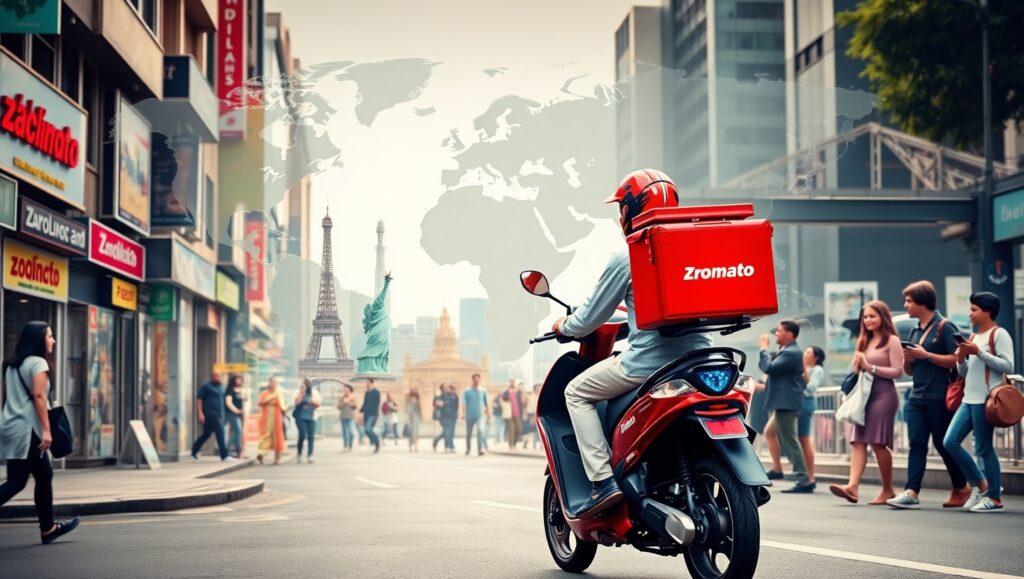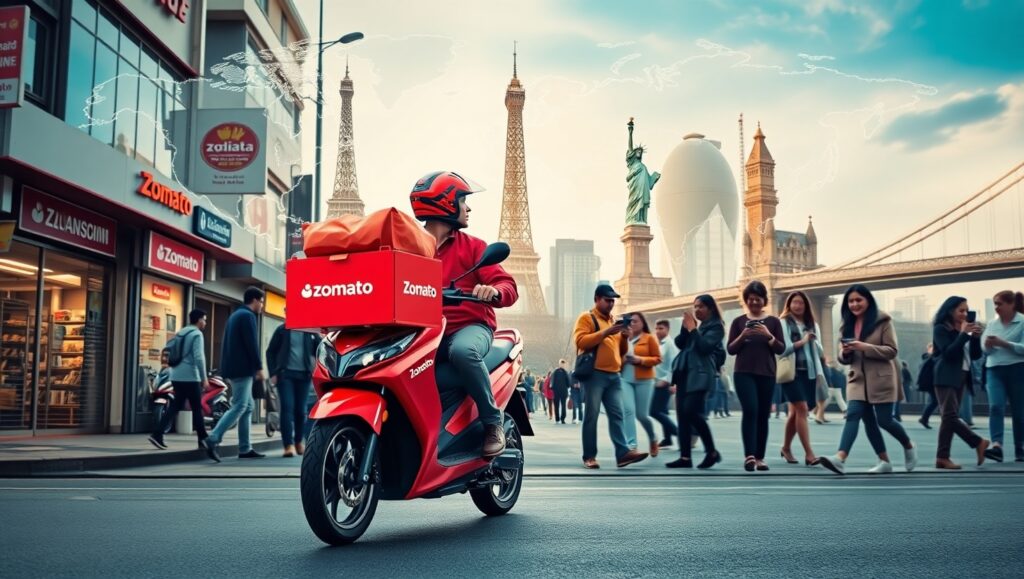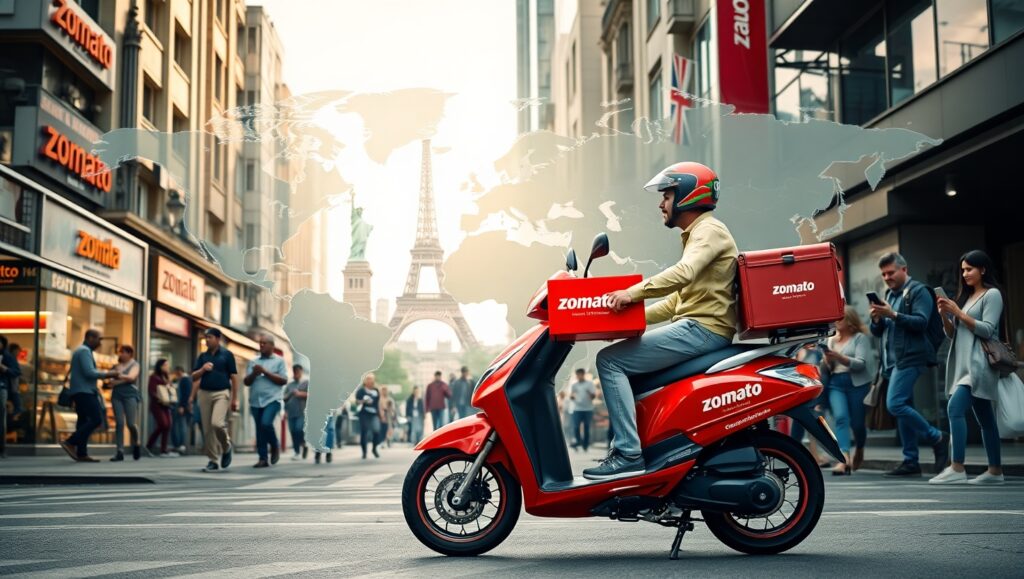Zomato, one of India’s most recognized startup success stories, has transformed from a small Delhi-based food discovery platform into a global food delivery and restaurant aggregator powerhouse. This case study explores Zomato’s growth journey, key business decisions, challenges faced, global expansion, and the strategies that fueled its rise to international fame.
1. The Humble Beginnings (2008–2010)

a. Origin Story
Zomato was founded in 2008 by Deepinder Goyal and Pankaj Chaddah under the name “Foodiebay.” The idea came from the inconvenience of standing in line to read restaurant menus. They started by scanning and uploading menus of restaurants in Delhi NCR.
b. Rebranding
In 2010, Foodiebay was rebranded to Zomato to create a more global brand identity.
2. India Expansion (2011–2014)
a. City-wise Rollout
Zomato quickly expanded to major Indian cities—Mumbai, Bangalore, Chennai, and Kolkata—offering restaurant listings, menus, photos, and user reviews.
b. User Engagement
The company focused on building a community of food lovers and reviewers, enhancing the trust and utility of the platform.
c. Monetization
Initial monetization came from restaurant advertising and premium listing placements.
3. Going Global (2012–2015)

a. First Steps Abroad
Zomato’s first international foray began with Dubai in 2012, followed by the UK, South Africa, Philippines, and New Zealand.
b. Acquisitions for Speed
To gain quick entry and local expertise, Zomato acquired local food portals such as:
- MenuMania (New Zealand)
- Lunchtime.cz (Czech Republic)
- Obedovat.sk (Slovakia)
- Gastronauci (Poland)
c. Customizing for Local Markets
Zomato adapted its offerings and UX for different languages and food cultures, which was key to its global adoption.
4. Evolution Into Food Delivery (2015–2018)
a. Pivot to Delivery
Recognizing the shift towards on-demand services, Zomato entered the food delivery space in India in 2015, competing with players like Swiggy and Uber Eats.
b. Logistics and Partnerships
Built its own logistics fleet and partnered with restaurants for order fulfillment.
c. Acquisitions in India
Acquired Runnr and TongueStun to enhance delivery capabilities and enter the corporate catering space.
5. Innovation and Product Expansion
a. Zomato Gold
Launched in 2017, Zomato Gold (later Zomato Pro) was a membership program offering discounts and exclusive perks, which drove user retention.
b. Cloud Kitchens
Partnered with restaurant brands to operate cloud kitchens under the Zomato Infrastructure Services model.
c. Hyperpure
Zomato launched Hyperpure, a B2B platform to supply fresh ingredients to restaurants, ensuring quality and generating new revenue streams.
6. Strategic Moves and IPO (2019–2021)
a. Acquiring Uber Eats India
In 2020, Zomato acquired Uber Eats India, consolidating its market leadership and increasing delivery volume.
b. Preparing for IPO
Streamlined operations, focused on profitability, and filed for IPO in 2021. The IPO was a major success, with Zomato becoming one of India’s first consumer-tech startups to list publicly.
7. Post-IPO Performance and Global Strategy
a. Focus on Core Markets
Post-IPO, Zomato exited some smaller international markets to focus on India and profitable global regions.
b. Investments
Invested in logistics, food robotics, and quick commerce, including stakes in Blinkit (formerly Grofers).
c. Brand Positioning
Positioned as a tech-first, lifestyle brand beyond just food delivery.
8. Challenges and Criticism
a. Competitive Pressure
Constant battle with Swiggy and new entrants in food delivery.
b. Profitability Concerns
Sustaining growth with profitability has been a consistent challenge, especially in thin-margin delivery services.
c. Labor and Partner Issues
Faced protests and backlash from delivery partners over pay and working conditions.
d. PR and Cultural Sensitivities
Zomato has had to carefully manage public relations and content on sensitive cultural issues.
9. Lessons for Startups
a. Start Simple, Scale Fast
Zomato began with a simple idea—menu listings—and rapidly scaled with a clear vision.
b. Localize for Global
Customizing for each market is critical to international success.
c. Data-Driven Growth
Zomato constantly uses data to optimize delivery, recommendations, and business decisions.
d. Be Agile
Pivoting from listings to delivery and then to B2B services shows the importance of adaptability.
e. Diversify Revenue
By branching into advertising, subscriptions, B2B, and logistics, Zomato built a more resilient business.
Conclusion
Zomato’s journey from a scrappy food directory to a global tech-enabled food company is filled with bold bets, rapid scaling, strategic acquisitions, and adaptive innovation. For Indian startups aspiring to scale globally, Zomato is a masterclass in ambition, resilience, and execution. It proves that with the right vision and persistence, Indian companies can compete and thrive on the world stage.
Disclaimer:The content provided in this blog post is for informational purposes only. The opinions expressed here are those of the author and do not necessarily reflect the views or opinions of Business Rahi. While we strive to ensure the accuracy and reliability of the information presented, we cannot guarantee the completeness, reliability, or suitability of the content for any particular purpose. Any reliance you place on such information is strictly at your own risk.
Buisiness Rahi is not responsible for any losses or damages arising from the use of the information shared in this blog post. We may feature links to external websites, but these do not constitute endorsements or recommendations. We encourage readers to conduct their own research and consult with professionals before making any business decisions.
For more information about our brand or policies, please refer to our official website or contact us directly.

